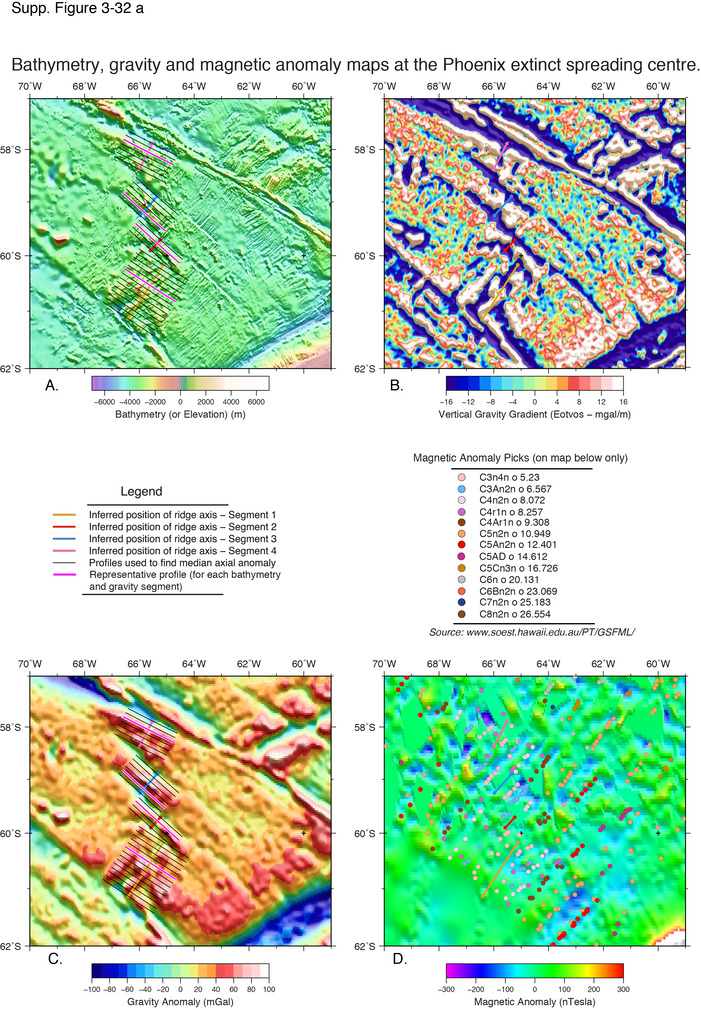| Ocean: | Pacific |
| Spreading center type: | Large-scale extinct mid-ocean ridge |
| Time of cessation: | 3.3 Ma, C2A (Livermore et al., 2000) |
| Subsequent active spreading center: | Rifting is active within the Bransfield Trough, that commenced spreading shortly after cessation of spreading at the Phoenix Ridge. |
| Cessation style: | Gradual slow down in spreading rate over 5 m.y. (Livermore et al., 2000; Eagles, 2004) |
| Later deformation or volcanism: | The central preserved segment of the ridge has morphology typical of a robust magma supply, but volcanism does not appear to postdate the time of cessation (Livermore et al., 2000). |
The Phoenix plate was a large oceanic plate that was important in the early development of the Pacific Ocean, and that has since been almost entirely subducted except for a small fragment in the southeast Pacific (Eagles and Scott, 2014), with cessation of spreading proposed at ca. 3.3 Ma (Livermore et al., 2000). The plate is proposed to have had active boundaries with the Pacific and Farallon plates during its history when a triple junction (Phoenix-Farallon-Pacific) spreading centre was active (Viso et al., 2005; Eagles and Scott, 2014). The Phoenix extinct ridge, however, represents the final location of the Phoenix-Antartic plate active spreading center, at the south western edge of the plate (Livermore et al., 2000; Eagles, 2004, Larter et al., 2002).
The extinct ridge has been well-studied and is featured in the 'Primary' tier of our study. Livermore et al. (2000), reported significant variability in the morphology of the three preserved axial segments, despite similar spreading rates on all segments in the final stages of spreading. Livermore et al., (2000) proposed that the unusual elevation of the flanks of the central preserved segment (referred to as P2 in the study), could reflect an excess magma supply simultaneous with the reduction in spreading rate at the segment.
The spreading ridge is thought to have ceased due to changes in relative plate boundary forces, due to either the cessation of spreading at the West Scotia Ridge, Scotia Sea (Livermore et al., 2000; Eagles, 2004), or a change in the dynamics of the collision of the western ridge segments with the Antarctic trench to the southwest (Livermore et al., 2000). More recent studies (Eagles, 2004; Eagles and Scott, 2014) support a change in the local stress regime due to cessation of spreading at the West Scotia Ridge, than may have led to an "incease in shear stress" at bounding fracture zones (Eagles, 2004).
Eagles, G., 2004, Tectonic evolution of the Antarctic-Phoenix plate system since 15 Ma, Earth and Planetary Science Letters, v. 217, p. 97-109.
Eagles, G. and Scott, B.G.C., 2014, Plate convergence west of Patagonia and the Antarctic Peninsula since 61 Ma, Global and Planetary Change, http://dx.doi.org/10.1016/j.gloplacha.2014.08.002
Larter, R. D., Cunningham, A. P., Barker, P. F., Gohl, K. and Nitsche, F. O., 2002. Tectonic evolution of the Pacific margin of Antarctica, 1. Late Cretaceous tectonic reconstruction. Journal of Geophysical Research, v. 107, no. B12, p. 5-1 - 5-19, doi:10.1029/2000JB000052.
Livermore, R., Balanyá, J.C., Maldonado, A., Martínez, J.M., Rodríguez-Fernández, J., de Galdeano, C.S., Zaldívar, J.G., Jabaloy, A., Barnolas, A., Somoza, L. and Hernández-Molina, J., 2000, Autopsy on a dead spreading center: the Phoenix Ridge, Drake Passage, Antarctica, Geology, v. 28, no. 7, p. 607-610.
Viso, R. F., Larson, R. L. and Pockalny, R. A., 2005, Tectonic evolution of the Pacific-Phoenix-Farallon triple junction in the South Pacific Ocean, Earth and Planetary Science Letters, v. 233, p. 179-194.


